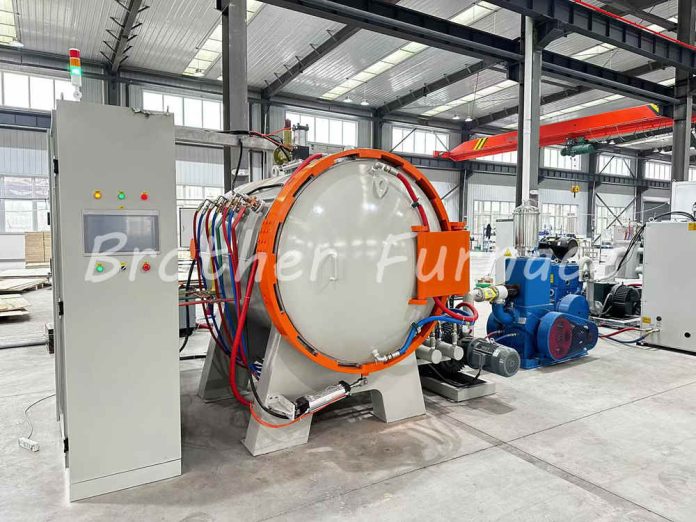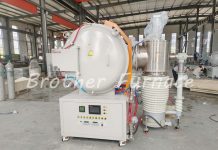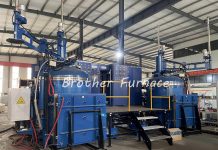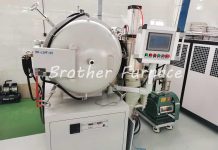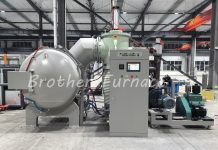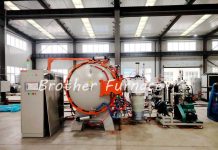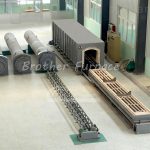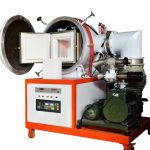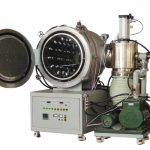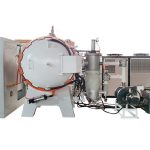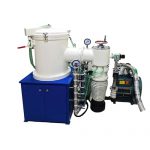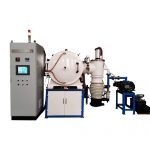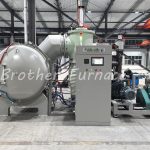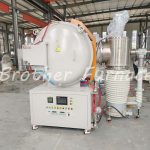Vacuum quenching is a critical heat treatment process where parts are rapidly cooled within a vacuum environment to achieve bright, clean surfaces and superior metallurgical properties. This process is widely applied to materials like carburized steel, alloy tool steel, high-speed steel, stainless steel, and various aging alloys for solution treatment. Vacuum quenching primarily utilizes two methods, distinguished by their cooling media: Vacuum GasQuenching and Vacuum Oil Quenching.
Vacuum Gas Quenching
- Process: The workpiece is heated under vacuum and then rapidly cooled in a chamber filled with high-purity inert gas (Argon, Helium) or non-reactive gas (Nitrogen).
- Applications: Mainly employed for tool steel, die steel, high-speed steel, ultra-high strength steel, and high-carbon high-chromium steel/mold steel categories.
- Advantages:
- Utilizes clean gas (Ar, He, N2) as the quenching medium.
- Results in a smooth, clean workpiece surface immediately after quenching, eliminating the need for post-quench oil cleaning.
- Generally cleaner process overall compared to oil quenching.
Key Features of Vacuum Gas Quenching Furnaces
Modern vacuum gas quenching furnaces incorporate sophisticated design features to achieve precise and uniform cooling:
Heating Chamber:
-
- Constructed with molybdenum/graphite heaters and insulation (molybdenum foil/graphite soft felt).
- Capable of reaching maximum temperatures up to 1350°C.
Gas Quenching System:
-
- Multi-Serial Graphite Spray Nozzles: Strategically located inside the heating chamber, often integrated with the inner wall. These nozzles ensure gas is sprayed uniformly over the workpiece surface during quenching.
- Gas Cooling System Components: Comprises a high-pressure wheel blower, multi-stage high-efficiency copper heat exchangers, and duct deflectors.
- Process: High-purity N2 or Ar is introduced during cooling. The blower forces gas through the heat exchangers and then directs it via duct deflectors and spray nozzles onto the workpiece, ensuring uniform heat extraction.
- Adjustable Pressure: Cooling gas pressure is precisely adjustable within the range of 1 to 10 bar, allowing control over the cooling intensity.
- High Cooling Rate: Capable of rapid cooling, achieving a drop from 1200°C to 300°C in less than 5 minutes.
See the details of our Vacuum Gas Quenching Furnace
Vacuum Oil Quenching
- Process: The workpiece is heated in a vacuum heating chamber, then transferred to a separate vacuum cooling chamber. This chamber is filled with high-purity nitrogen, and the workpiece is immediately immersed into a tank of agitated quenching oil for rapid cooling.
- Applications: Primarily used for alloy structural steel, bearing steel, spring steel, die steel, and high-speed steel. Also suitable for annealing and air-cooling processes for these materials.
- Advantages:
- Produces bright workpieces with excellent microstructural properties.
- Eliminates surface oxidation and decarburization.
- Offers faster cooling rates compared to gas quenching.
Key Features of Vacuum Oil Quenching Furnaces
Modern vacuum oil quenching furnaces integrate specialized systems for rapid, contamination-free cooling:
Heating Chamber:
-
- Construction: Identical to gas quenching models:
- Molybdenum/graphite heaters with molybdenum foil/graphite soft felt insulation.
- Max temperature: 1350°C for high-alloy steel processing.
- Construction: Identical to gas quenching models:
Oil Quenching System:
-
- Dual-Chamber Design:
- Workpieces are heated in the vacuum heating chamber, then transferred to a separate vacuum cooling chamber.
- Gas Purging:
- The cooling chamber is filled with high-purity nitrogen (N₂) before quenching to prevent oxidation.
- Immersion Quenching:
- Workpieces are rapidly submerged into a quenching oil tank immediately after nitrogen purging.
- Agitation System:
- Oil is violently agitated during quenching to eliminate vapor pockets and ensure uniform heat extraction.
- Cooling Medium:
- Specialty quenching oils (e.g., low-vapor-pressure oils) enabling faster cooling than gas quenching.
- Dual-Chamber Design:
See the details of our Vacuum Oil Quenching Furnace
Contrast
| Feature | Oil Quenching |
Gas Quenching |
|
Cooling Medium |
Agitated oil |
High-purity gas (N₂/Ar/He) |
|
Post-Process |
Requires oil cleaning |
No cleaning needed |
|
Cooling Speed |
Faster (ideal for thick sections) |
Adjustable via pressure (1–10 bar) |
|
Workpiece Cleanliness |
Bright surface, but oily residue |
Pristine, dry surface |
Conclusion
Vacuum quenching furnaces, offering both oil and gas quenching capabilities, are essential tools in modern precision heat treatment. They provide significant advantages over traditional atmospheric processes, primarily the elimination of oxidation and decarburization, resulting in bright, clean surfaces and superior material properties. Vacuum gas quenching furnaces, in particular, represent a cleaner and increasingly popular solution, featuring advanced nozzle designs, high-pressure gas circulation, rapid cooling rates, and adjustable parameters to meet the stringent requirements of high-performance alloys like tool steels, high-speed steels, and ultra-high strength steels. The precise engineering of components like graphite nozzles, efficient heat exchangers, and non-stick material platforms ensures consistent, high-quality results.
Contact us now for a custom quote or free consultation.
Vacuum gas quenching furnace standard model:
| Model | Chamber Size (W*H*D)mm | Max. Temp (℃) | Heating Elements | Capacity (KG) | Power (KW) |
Max. Vacuum (Pa) |
|---|---|---|---|---|---|---|
| BR-QCL-334G | 300*300*450 | 1350 | Graphite | 100 | 50 | 7×10-1 Pa |
| BR-QCL-446G | 400*400*600 | 1350 | Graphite | 200 | 80 | 7×10-1 Pa |
| BR-QCL-557G | 500*500*700 | 1350 | Graphite | 300 | 120 | 7×10-1 Pa |
| BR-QCL-669G | 600*600*900 | 1350 | Graphite | 500 | 150 | 7×10-1 Pa |
| BR-QCL-8812G | 800*800*1200 | 1350 | Graphite | 900 | 260 | 7×10-1 Pa |
| Model | Chamber Size (W*H*D)mm | Max. Temp (℃) | Heating Elements | Capacity (KG) | Power (KW) |
Max. Vacuum (Pa) |
|---|---|---|---|---|---|---|
| BR-QCL-334G | 300*300*450 | 1350 | Molybdenum | 100 | 50 | 7×10-1 Pa |
| BR-QCL-446G | 400*400*600 | 1350 | Molybdenum | 200 | 80 | 7×10-1 Pa |
| BR-QCL-557G | 500*500*700 | 1350 | Molybdenum | 300 | 120 | 7×10-1 Pa |
| BR-QCL-669G | 600*600*900 | 1350 | Molybdenum | 500 | 150 | 7×10-1 Pa |
| BR-QCL-8812G | 800*800*1200 | 1350 | Molybdenum | 900 | 260 | 7×10-1 Pa |
* Other sizes can be customized.
Vacuum oil quenching furnace standard model:
| Model | Chamber Size (W*H*D) mm | Max. Temp (°C) | Capacity (KG) | Power (KW) | Max. Vacuum (Pa) |
|---|---|---|---|---|---|
| BR-YCL-334 | 300*300*450 | 1350 | 100 | 50 | 7×10-1 Pa |
| BR-YCL-446 | 400*400*600 | 1350 | 200 | 80 | 7×10-1 Pa |
| BR-YCL-557 | 500*500*700 | 1350 | 300 | 120 | 7×10-1 Pa |
| BR-YCL-669 | 600*600*900 | 1350 | 500 | 150 | 7×10-1 Pa |
| BR-YCL-8812 | 800*800*1200 | 1350 | 900 | 260 | 7×10-1 Pa |
* Other sizes can be customized.
More Vacuum Furnaces:
Follow us on Facebook

